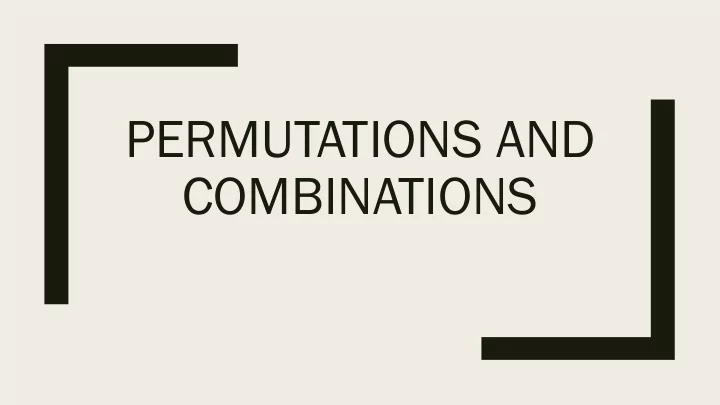

PERMUTATIONS AND COMBINATIONS
Finite Mathematics for Data Science ■ Statistics ■ Probability ■ Set Theory ■ Combinatorics
‘Combination’ in Everyday Language ■ Everyday language not precise about the meaning of the word ‘combination’ – “The soup includes a combination of fish and seafood items” ■ Order in which the ingredients are listed does not matter. – “The combination of the lock is 6-16-28. ■ Order does matter here.
Math has precise meanings ■ When order does not matter -> combination. ■ When order does matter -> permutation. ■ Permutations and combinations are closely connected – as are the formulas for calculating them. ■ Always more permutations than combinations. – 1 combination of a,b,c. – 6 permutations of a,b,c: ■ abc, acb, bac, bca, cab, cba [no repetition allowed] ■ Easiest to look at permutations first; then at combinations
Permutations with Repetitions ■ How many permutations with repetition allowed when we are making a 3 letter permutation from a set with 5 elements: a, b, c, d, e ■ aaa, aab, aac, aad, aae, aba, abb, abc, … ■ While you could list them all, you could also reason about how many there are: – First letter, there are 5 choices. – Second letter, there are 5 choices – Third letter there are 5 choices. ■ Hence, there are 5x5x5 = 125 choices. ■ More generally, choosing r of something with n different types [where order matters and repetitions are allowed, n x n x n x … x n (r times = n r
Examples of permutation with repetitions ■ How many three number combinations in a lock are there if the possible numbers are the digits 0 through 9? ■ 10 x 10 x 10 = 1000 ■ Cars sometimes have locks with four-digit codes but the choices of numbers are 0/1 2/3 4/5 6/7 8/9 – In this case it is 5x5x5x5 = 625
Permutation without repetition ■ How many permutations could a rack of pool balls be in? – Numbers 1 through 15, plus a white (cue) ball (think of it as 0) – Without repetition, our choices get reduced each time. – Permutation without repetition 16 choices for first one, 15 choices for second one, etc. – Permutations = 16x15x14x…x3x2x1 = 16! (more than 20 trillion) ■ Suppose you only want 3 ball permutation without repetition – 16x15x14 = 3360 ■ Factorial symbol n! = n x (n-1) x (n-2 )x…x 2 x 1 ■ Special cases: 1! = 1, 0! = 1
General Rule of P(n,r) ■ If only choosing 3 from the group of 16 balls, the permutations without repetition is 16 x 15 x 14 ■ But this can be written as 16!/13! ■ General rule of permutations without repetition: The number of permutations without repetition where n is the number of things to choose from, and r is the number of items we are choosing is given by n! / (n-r)!
Example P(n,r) ■ How many ways can first and second place be awarded in a race of 10 contestants? P(10,2) = 10! / (10 – 2)! = 3628800 / 40320 = 9 = 10 x 9
Combinations ■ Also two types – Repetition allowed (change in your pocket) – Repetition not allowed (lottery numbers) ■ Start with combinations without repetition (easiest to explain) ■ Way to do the analysis – First, do as a permutation problem (where order matters) – Second, alter the answer to get rid of the concern about order.
Combinations C(n,r) ■ Choose three balls from 16 (no repetition) ■ We did that already and got 16! / (16 – 3)! ■ Second, we divide by 3! Because there are 3! ways in which 3 balls can be ordered ■ Then the number of combinations of 3 balls taken from 16, without repetition, is ■ [16! / (16 – 3)!] / 3! = 16 x 15 x 14 / 3 x 2 x 1 = 560 ■ General formula for C(n,r) = n!/r!(n-r)! ■ Expressed as ”n choose r”
Symmetry ■ C(n,r) = C(n-r,r) ■ Work out the formulas
The hard case: combinations with repetition ■ Will not motivate it: ■ C rep (n,r) = [r+n-1]!/r![n-1)! ■ Example: how many variations of triple scoop of ice cream with the ice cream flavors banana, chocolate, lemon, strawberry, vanilla ■ [3+5-1]!/3![5-1]! = 7!/[3! X 4!] = 5040/[6x24] = 35
Recommend
More recommend